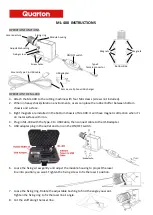
Through the Block's end time, it is possible to calculate the laser
fi
ring time for every channel in the Block.
Take Block 6 for example, assuming Block 6's end time is t6, then:
01)
02)
03)
04)
Laser ID 2’s
fi
ring time: (t6-3.62) μs;
Laser ID 20’s
fi
ring time: (t6-3.62) μs;
Laser ID 17’s
fi
ring time: (t6-1.304*1-3.62) μs;
Laser ID 15’s
fi
ring time: (t6-1.304*3-1.968*1-3.62) μs;
05)
06)
07)
08)
Laser ID 12’s
fi
ring time: (t6-1.304*3-1.968*2-3.62) μs;
Laser ID 1’s
fi
ring time: (t6-1.304*5-1.968*3-3.62) μs;
Laser ID 19’s
fi
ring time: (t6-1.304*5-1.968*3-3.62) μs;
Laser ID 6’s
fi
ring time: (t6-1.304*7-1.968*4-3.62) μs;
End time of Block 20: (t0-28.58) μs;
End time of Block 19: (t0-28.58) μs;
End time of Block 18: (t0-28.58-55.56) μs;
End time of Block 17: (t0-28.58-55.56) μs;
End time of Block 16: (t0-28.58-55.56*2) μs;
01)
02)
03)
04)
05)
End time of Block 15: (t0-28.58-55.56*2) μs;
End time of Block 14: (t0-28.58-55.56*3) μs;
End time of Block 13: (t0-28.58-55.56*3) μs;
End time of Block 12: (t0-28.58-55.56*4) μs;
End time of Block 11: (t0-28.58-55.56*4) μs;
06)
07)
08)
09)
10)
End time of Block 10: (t0-28.58-55.56*5) μs;
End time of Block 9: (t0-28.58-55.56*5) μs;
End time of Block 8: (t0-28.58-55.56*6) μs;
End time of Block 7: (t0-28.58-55.56*6) μs;
End time of Block 6: (t0-28.58-55.56*7) μs;
11)
12)
13)
14)
15)
End time of Block 5: (t0-28.58-55.56*7) μs;
End time of Block 4: (t0-28.58-55.56*8) μs;
End time of Block 3: (t0-28.58-55.56*8) μs;
End time of Block 2: (t0-28.58-55.56*9) μs;
End time of Block 1: (t0-28.58-55.56*9) μs;
16)
17)
18)
19)
20)
There are 20 Blocks in every Point Cloud UDP Data Packet.
In the dual return mode, Block (1, 2) are corresponding to dual return ranging data for the same 20 channels laser
fi
ring, so they have
the same
fi
ring time for each laser and the same end time for the Block. Similarly, Block (3, 4) and so on have same
fi
ring and end time.
The calculation of each Block's end time is as follows:
Dual Return Mode
Pandar20A
- 3 4 -
















































